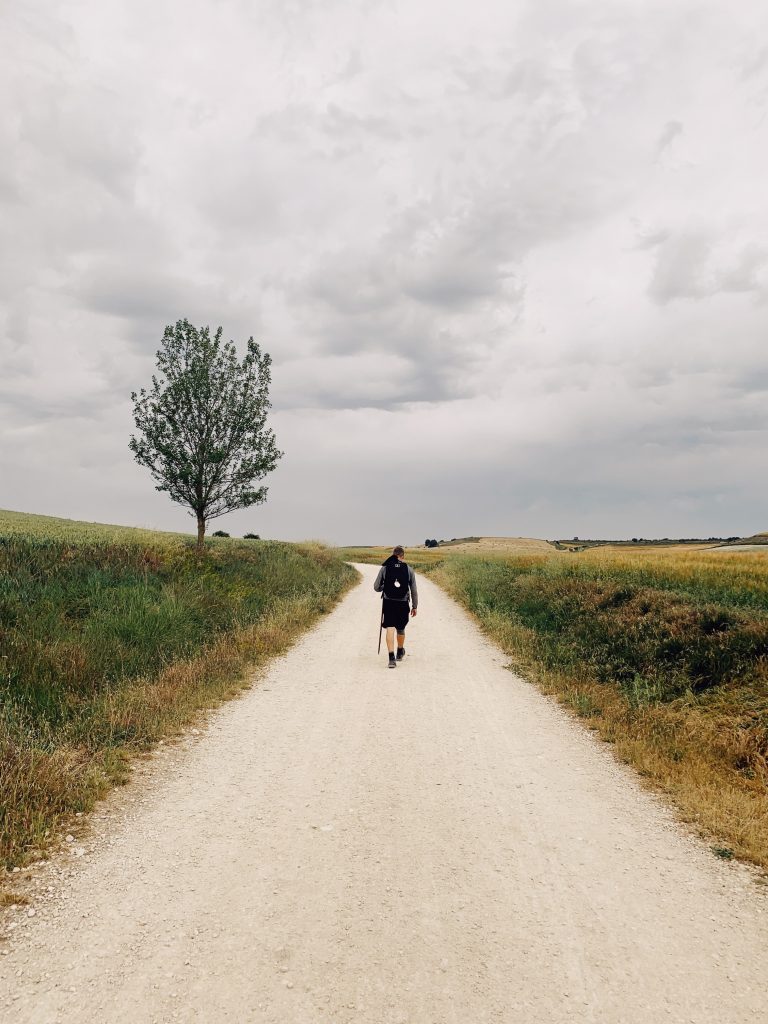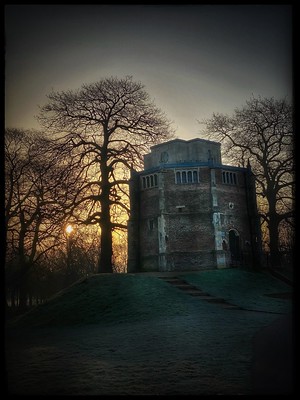The second most popular place to visit in England between about 1200 and 1537
During the Middle Ages the shrine at Walsingham was the second most popular pilgrimage site in the England after the shrine of Thomas Becket at Canterbury. There are at least three reasons behind its popularity. First, it was dedicated to the Virgin Mary and she took precedence over all the saints and martyrs. Secondly, it was associated with fertility which was a major concern during this period. And thirdly, during the Crusades, access to the holy sites in Palestine (and particularly Jerusalem) was difficult and dangerous, if not impossible.

Over the years thousands of pilgrims would have made their way to the small Norfolk village. For some of them, Walsingham was an interim stopping off point before continuing a longer journey on to Santiago de Compostela in north western Spain.
Walsingham’s importance can be seen from the fact that every English monarch, from Henry II until the Reformation, is known to have paid at least one visit to Walsingham. (Edward I visited thirteen times.) In 1364, Edward III gave safe conduct to King David of Scotland and twenty knights to make pilgrimage to Walsingham. These royal visits even included Henry VIII who was responsible for its eventual destruction.
The Route to Walsingham

The pilgrim routes to Walsingham were well known. The main route from London was via Waltham Abbey, Newmarket, Thetford, and Fakenham. From the north, pilgrims crossed Fens via the ancient silt bank route and came through King’s Lynn (then called Bishop’s Lynn), before going to Flitcham, Rudham and Coxford. From the east the route ran through Norwich and Attlebridge.
For those who chose to travel by boat, the East Coast ports with monasteries were the motorway service stations of the day. Lynn had church towers and five religious houses and was an important religious centre. Once disembarked in Lynn the seafaring pilgrims could give thanks for a safe journey at the Chapel on St Ann’s Quay or at the Lady Bridge Chapel (and later at the Red Mount Chapel).
The more affluent would have continued on the next part of their journey to Castle Acre by boat via the River Nar at the South Gate. Others would have walked the remaining distance from the port.
The Reasons for Travel to Walsingham
The reasons for going on such a pilgrimage must have been as many and as varied as the thousands of pilgrims. However, most pilgrims were making the journeys for the good of their soul.
- Some believed that praying close to particular relics or artefacts were especially effective.
- Some were seeking healing from illness.
- Some were making the journeys, sacrificing time, money, and effort, in order to do a penance to atone for a particular sin (and therefore reduce time spent in purgatory after death).
- Some believed that a particular saint might offer a degree of easing and protection while the pilgrim was in purgatory in the afterlife.
The dangers involved in some pilgrimages added to the allure. Discomfort and suffering were thought to be necessary for the redemption of the soul and the remission of sins.
The Walsingham Legend
In 1061 a woman prayed that God would show her a way to honour Him. The Virgin Mary was said to have appeared to Richeldis de Faverches and showed her the house in Nazareth where the Angel Gabriel had originally appeared to Mary.
‘Look, daughter’ said Our Lady. ‘Take the measurements of this house and erect another one like it in Walsingham, dedicated to praising and honouring me. All who come there shall find help in their need. It shall be a perpetual memorial to the great joy of the Annunciation, ground and origin of all my joys and the root of humanity’s gracious Redemption. This came about through Gabriel’s message that I would be a mother through my humility, and conceive God’s Son in virginity.’ (Pynson Ballad 1485)
Lady Richeldis built the house (or the house was miraculously transported for her), and as pilgrims began to flock to Walsingham, Geoffrey de Faverches, Richeldis’ son, had a priory and a church built. Its running was then given to the Augustinian Canons with papal approval (c.1150). Walsingham became one of the greatest shrines in Medieval Christendom.
Erasmus, the great theologian and philosopher, visited the shrine in 1512 and was impressed with the treasure but more sceptical of the purpose. He remarked drily that there was a brilliant and elegant temple (templum est nitidum et elegans verum) for the non-residence of the Blessed Virgin (in eo non habitat virgo).
Walsingham And The Dissolution
Between Easter 1536 and Easter 1540 six hundred and sixty monasteries and one hundred and eighty friaries in England and Wales were closed, their communities dispersed, and their assets taken into Crown ownership.
Roger Ascham, when visiting Cologne in 1550, remarked: ‘The Three Kings be not so rich, I believe, as was the Lady of Walsingham.’ The shrine’s wealth made it particularly vulnerable to Henry’s attention. However, a series of visitations by bishops in the years prior to the dissolution revealed that fame and the attraction of the wealth had proved too much for some of the resident monks. There are accusations of drunkenness, missing jewellery, theft of money, and bullying.
In 1538 at Canterbury, Becket’s bones were removed and his tomb was destroyed. It is not known what happened to them but rumour had it that they were burned. In the same year the Walsingham property was handed over to the King’s Commissioners and the famous statue of Mary was taken to Chelsea to be burned.
Popular attachment to the shrine at Walsingham resurfaced early in 1540 when a “pore woman” of Wells proclaimed a new miracle for the image of the Blessed Virgin, taken down almost two years before. After an examination in London she was returned to the custody of the constable and ‘sett in the stokkes … wyth a papire sett aboute her hede’ declaring her ‘a reporter of false tales’.
By 1580 the main attraction at Walsingham was the sale of crocuses.
After Roman Catholic Emancipation in 1829 public pilgrimages to Walsingham restarted and a new shrine was built. Nothing remains of Walsingham’s original shrine. However, its site is marked on the lawn in “The Abbey Grounds” in the village.
Two Walsingham Men Martyred In Lynn
Of course, many people relied on monasteries for their work and livelihoods, and as the closures started to happen, some individuals were brave enough to protest. In 1536, a rebellion which became known as The Pilgrimage of Grace, started in East Yorkshire and demanded an end to Dissolution.
The rebellious groups from Yorkshire and Lincolnshire of around 40,000 men assembled at Doncaster to march against Henry VIII. They met the Duke of Norfolk’s army of around 8,000 men, but agreed to disperse when the Duke agreed to meet the rebels’ demands. (Norfolk’s promises were not fulfilled and the original rebel leaders were captured and executed.)
The Walsingham Plot took place just before the dissolution of the Augustinian Priory and began in November 1536 when four Lincolnshire men appeared at Walsingham speaking openly of carrying the cause ‘goon through the realme’, if Norfolk and Suffolk were ‘rysen’ with their northern neighbours (Louth, Lincoln, York).
The plot drew in about thirty conspirators. Their intention was to raise an eastern group in conjunction with the larger Pilgrimage of Grace to challenge Henry’s policies. However, thanks to the the cooperation of Richard Vowell, prior of Walsingham, their plans were leaked to London, and a number were sentenced to death.
On Wednesday 30th April 1537 Canon Nicholas Mileham, the sub-prior of Walsingham Priory, and George Guisborough, a yeoman and chorister of Walsingham village were hung, drawn and quartered just outside the village in what is now known as ‘Martyrs Field’. Their heads were then placed on the Priory Gatehouse.

In order to spread the message throughout the County that the rebellion would not be tolerated, the others were divided and sent to Norwich, Yarmouth, and Lynn. On Saturday, 26 May, five were executed at Norwich; on 28 May, two more were executed at Yarmouth. On 1 June 1537 a priest, William Gysburgh, along with a Carmelite Friar, John Pecock, were hung, drawn, beheaded, and quartered for high treason on the Tuesday Market Place in Lynn (see here).
© James Rye 2022
Sources
- Clark, J.G. (2021) The Dissolution of the Monasteries, Yale University Press
- Hillen, H.J. (1907) History of the Borough of King’s Lynn, Vol. 1 & 2, EP Publishing Ltd
- Robinson, D.M. (2016) England’s Nazareth: Walsingham Priory, Norfolk, Country Life, 210 (23 March 2016), 34−41
- Rowlands, K.W. (1999) The Friars: A History of the British Medieval Friars, The Book Guild
- https://www.british-history.ac.uk/vch/norf/vol2/pp394-401
- https://www.walsingham.org.uk/history/
- https://www.walsinghamanglican.org.uk/the-shrine-2-2/the-story-so-far/
- https://www.worldwidewriter.co.uk/walsingham-shrine-norfolk-history-and-pilgrimage.html
- https://www.newdawn.org.uk/the-history-of-walsingham/
- https://catholicismpure.wordpress.com/2013/04/13/the-holy-martyrs-of-walsingham/

[…] Pecock, were drawn, hung, beheaded, and quartered for high treason on the Tuesday Market Place. These two were part of a “conspiracy” objecting to Henry VIII’s dissolution of the… in particular, the closing of the shrine at Walsingham. (It is worth pointing out that Henry […]
I have learnt a lot of new information here. This is thoroughly researched and very well presented piece of writing and one of my favourite post of yours to date.
I love visiting Walsingham and used to look at The Red Mount everyday when I walked across the park to work. I had no idea that the River Nar was by the Southgates.
Thanks Helen.
The River Nar flowed into the Wash at Lynn before the Ouse did and was a navigable route for the richer pilgrims to Castle Acre on the way to Walsingham.
[…] Lynn was an important stopping off post on the way to the Shrine at Walsingham which was established at the end of the C11th. Lynn also had two chapels dedicated to Our Lady […]
[…] most popular pilgrimage site in the England after the shrine of Thomas Becket at Canterbury. The Walsingham Shrine was dedicated to the Virgin Mary and she took precedence over all the saints and martyrs. […]
[…] Going on a pilgrimage. (See Pilgrims Through Lynn To Walsingham.) […]
[…] Going on a pilgrimage. (See Pilgrims Through Lynn To Walsingham.) […]
[…] Through Lynn to Walsingham […]